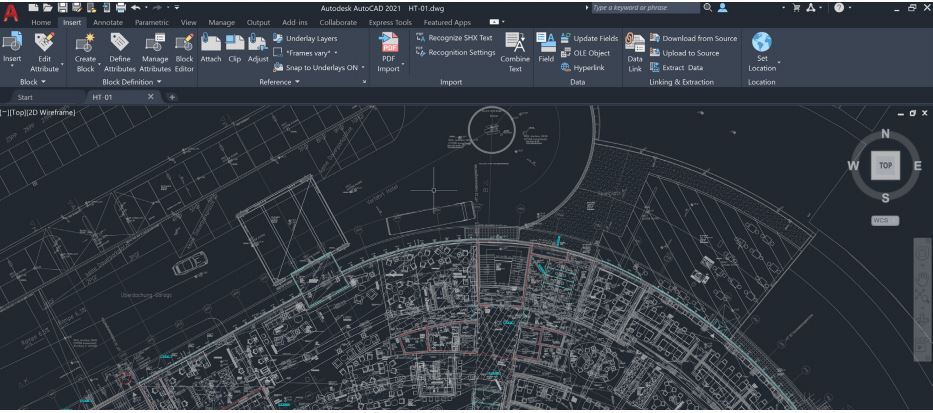Equipped with the right applications, a computer can be of great help in virtually any domain of activity. When it comes to designing and precision, no other tool is as accurate as a computer. Moreover, specialized applications such as AutoCAD give you the possibility to design nearly anything ranging from art, to complex mechanical parts or even buildings. Suitable for business environments and experienced users After a decent amount of time spent installing the application on your system, you are ready to fire it up. Thanks to the office suite like interface, all of its features are cleverly organized in categories. At a first look, it looks easy enough to use, but the abundance of features it comes equipped with leaves room for second thoughts. Create 2D and 3D objects You can make use of basic geometrical shapes to define your objects, as well as draw custom ones. Needless to say that you can take advantage of a multitude of tools that aim to enhance precision. A grid can be enabled so that you can easily snap elements, as well as adding anchor points to fully customize shapes. With a little imagination and patience on your behalf, nearly anything can be achieved. Available tools allow you to create 3D objects from scratch and have them fully enhanced with high-quality textures. A powerful navigation pane is put at your disposal so that you can carefully position the camera to get a clearer view of the area of interest. Various export possibilities Similar to a modern web browser, each project is displayed in its own tab. This comes in handy, especially for comparison views. Moreover, layouts and layers also play important roles, as it makes objects handling a little easier. Sine the application is not the easiest to carry around, requiring a slightly sophisticated machine to properly run, there are several export options put at your disposal so that the projects itself can be moved around. Aside from the application specific format, you can save as an image file of multiple types, PDF, FBX and a few more. Additionally, it can be sent via email, directly printed out on a sheet of paper, or even sent to a 3D printing service, if available. To end with All in all, AutoCAD remains one of the top applications used by professionals to achieve great precision with projects of nearly any type. It encourages usage with incredible offers for student licenses so you get acquainted with its abundance of features early on. A lot can be said about what it can and can't do, but the true surprise lies in discovering it step-by-step.

Download ····· DOWNLOAD (Mirror #1)
Download ····· DOWNLOAD (Mirror #1)
AutoCAD 20.0 Crack+ [Mac/Win]
The first AutoCAD release was a PC version, but only on the Microsoft Windows operating system. AutoCAD was originally released for the IBM-compatible PC, but many of the newer releases are now compatible with Apple Macintosh, Microsoft Windows, and Linux-based systems. The earliest version of AutoCAD was 4.5. In November 1984, AutoCAD 2.5 was introduced. In July 1986, AutoCAD 7.0 was released. The AutoCAD 2017 update added several new features, including an enhanced XRef database (XDB) and a new layer filtering dialog box. In addition, this update supports several new camera and lens types, a new block editor, and a new Appearance panel. AutoCAD was created by Ron Proulx, a member of the Editorial department of the Department of Civil Engineering and Architecture at the University of Calgary, Alberta, Canada. In 1981, he worked as a computer programmer for Reengineering of Systems Inc. (now known as Reengineering-Design Automation Inc.) in Sausalito, California. At the end of 1981, he left Reengineering and joined the University of Calgary. He completed his B.Sc. degree in computer science in 1983. In the early 1980s, he was one of a number of academics and engineers at the University of Calgary, Alberta, who were working to develop CAD software for engineering use. The CAD tool eventually developed was called ECAD (EDition, Calculation, Analysis, Design), which was launched in 1981. The following year, it was renamed AutoCAD and was released for purchase from the University of Calgary in 1982. Prior to the release of AutoCAD, the university needed to create a software package that was inexpensive enough for the majority of users who would be within universities and public engineering offices. In 1981, Ron Proulx joined the Editorial department of the Department of Civil Engineering and Architecture, where he worked until 1984 as a developer and writer. Proulx was the one who created and wrote the ECAD software, with fellow academic Gary Bell, working on the financial and marketing side. At the time, Proulx worked for Reengineering-Design Automation, Inc. (Reengineering), a computer consulting firm in Sausalito, California. By 1981, the need for CAD software was high, and university students had become interested in computer-aided design. The ECAD CAD package was created by Prou
AutoCAD 20.0 With Key [32|64bit]
There are 3 different types of Xrefs: Xref, Xref+ (Xref_Plus) and Xref+ (Xref_Plus_Plus). The difference between Xref and Xref_Plus is whether the Xref header is automatically added to the Xref+ header and Xref+ (Xref_Plus) are created if an Xref+ header is not present. References External links Official AutoCAD Cracked 2022 Latest Version website AutoCAD Category:C++ software Category:Computer-aided design software Category:Computer-aided design software for Windows Category:Cross-platform software Category:Desktop publishing software Category:Dynamics (software) Category:IA-32 operating systems Category:Proprietary software Category:Professional vector graphics editors Category:Serial port software for Linux Category:Serial port software for Windows Category:Video game development software Category:Video game engines Category:Video game engines using OpenGL Category:Video game engines using Direct3D Category:Video game engines using the Ilm architecture Category:Video game engines Category:Windows media players J. [Maclachlan]{}, L. E. [Pogorelov]{}, and A. M. [Shapiro]{}, Astrophys. J. **707**, 456 (2009). L. [Pogorelov]{}, L. [Zank]{}, B. [Richter]{}, R. [Owens]{}, A. [Mukherjee]{}, K. [Rao]{}, M. [Steiner]{}, A. [Vlasov]{}, H. [Wang]{}, A. [Zheleznyakov]{}, and S. [Kuznetsov]{}, Astrophys. J. **710**, L106 (2010). L. [Pogorelov]{}, A. [Vlasov]{}, B. [Richter]{}, K. [Zheleznyakov]{}, and J. [Pasachoff]{}, Astrophys. J. **745**, 14 (2012). A. [Shukurov]{}, and A. V. [ ca3bfb1094
AutoCAD 20.0
Open the Inventor software with the keygen and run the Autocad.exe file. Open the Inventor software with the keygen and run the Autocad.exe file. Open the Inventor software with the keygen and run the Autocad.exe file. Install the Autocad software. If you already installed the software, please delete Autocad.exe. Edit in the Inventor software. After installing the Autocad software, please launch Autocad in the Inventor software. If the next example does not work well for you, try using the autocad software from a newly signed product key. In the Inventor software, in the File tab > Open > Preferences > New Project > IFile > Files and folders > IFileOpenDialog > type file::autocad.dxf > OK > next > next > next > ok > next > next > next > next > next > next > next > next > next > ok > next > next > next > next > next > next > next > next > next > next > next > next > ok > next > next > next > next > next > next > next > next > next > next > next > next > ok > next > next > next > next > next > next > next > next > next > next > next > next > ok > next > next > next > next > next > next > next > next > next > next > next > next > ok > next > next > next > next > next > next > next > next > next > next > next > next > ok > next > next > next > next > next > next > next > next > next > next > next > next > ok > next > next > next > next > next > next > next > next > next > next > next > next > ok > next > next > next > next > next > next > next > next > next > next > next > next > ok > next > next > next > next > next > next > next > next > next > next > next > next > ok > next > next > next > next > next > next > next > next > next > next > next > next > ok >
What’s New In?
Freehand annotation with direct input: Add more of your ideas directly to your drawings. Take advantage of the X, Y and vector-based straightening tools to add to your drawings without a planer. You can also use shape layers and add your own annotations using AutoCAD drawing tools. (video: 3:50 min.) Direct Link Creation between applications: Use Direct Link to connect AutoCAD to other applications and share information. You can share screens from other applications with the Viewer in AutoCAD. (video: 1:47 min.) Live Review: Get instant feedback on how your drawings look and how you can improve them. You can create and test a new document on the fly. (video: 3:28 min.) Stencils: Export your existing layers as a stencil set and use those stencils within new documents. Work from a single, scalable, standard graphic format with no conversion required. (video: 1:20 min.) Stick Shift Lines: Change your drafting style and your attitude. No more back and forth on stick shifts, just shift to select edges or corners, or even snap to them. (video: 1:11 min.) AutoCAD Link: Share CAD drawings and data easily and securely through the cloud using Cloud Link. You can also download, view and print a new version of the drawing in the cloud. (video: 2:12 min.) Save: If it’s not in your drawing, you don’t need to remember. That’s why AutoCAD saves and recovers after every change to ensure that it keeps your most recent, accurate drawing. (video: 3:02 min.) Lights and Shading: Lights and shadows are part of every design. You can change color and brightness of the light source to get the look you want. (video: 2:16 min.) AutoCAD will give you the flexibility to create lines as you design them or as they appear on screen in real-time. For example, you can draw a line anywhere on screen and then lock the line’s position, while enabling you to edit the line later. You can also draw a line with no visible control and edit it later with Move, Select, and Scale commands. (video:
https://ed.ted.com/on/FR9XRsfZ
https://ed.ted.com/on/I8kpKRcz
https://ed.ted.com/on/84NYvvjA
https://ed.ted.com/on/PDDok5CF
https://ed.ted.com/on/m8ySYf4t
System Requirements:
Windows 7 Mac OS 10.6 Linux (Arch/Debian, Ubuntu) Minimum: OS: Windows 7 Processor: Intel Core 2 Duo or equivalent Memory: 2GB RAM Graphics: 1GB Video Memory (AMD Radeon HD4300) or equivalent Hard Drive: 10GB free disk space Sound Card: DirectX 9.0 compatible sound card with 44.1KHz, 32bit stereo, 6 channels. Soundcard must be enabled in the BIOS. Other: A copy of
https://mymiddlevilledda.com/wp-content/uploads/2022/07/qubivig.pdf
https://ajkersebok.com/wp-content/uploads/2022/07/verisob.pdf
https://www.scoutgambia.org/autocad-23-0-crack-free-download-2022/
https://booktiques.eu/wp-content/uploads/2022/07/AutoCAD-65.pdf
https://theblinkapp.com/autocad-crack-for-pc-7/
https://contabilidad.xyz/autocad-21-0-crack-torrent-for-pc/
https://positiverne.dk/wp-content/uploads/AutoCAD_Crack__Activation_Key_Free_Download_April2022.pdf
https://malekrealty.org/autocad-crack-lifetime-activation-code-pc-windows-latest-2022/
http://hotelthequeen.it/2022/07/24/autocad-crack-product-key-full-april-2022/
https://www.ocacp.com/wp-content/uploads/2022/07/AutoCAD_Crack_Free_License_Key_Free_X64_Latest_2022.pdf
https://katrinsteck.de/wp-content/uploads/AutoCAD-81.pdf
https://moronencaja.com/wp-content/uploads/2022/07/nevtia.pdf
https://warriorplus.com/o2/a/vqvqcq/0?p=28860
https://www.travelrr.com/autocad-crack-latest-2022-5/
https://melaniegraceglobal.com/wp-content/uploads/2022/07/yonngeo-1.pdf
https://xn--80aagyardii6h.xn--p1ai/autocad-2019-23-0-download-latest-128640/
https://xtc-hair.com/autocad-22-0-crack-activation-code-with-keygen-download-3264bit/
https://onlineshopmy.com/wp-content/uploads/2022/07/brorawd-1.pdf
https://gracepluscoffee.com/autocad-24-1-crack-full-version-x64-updated-2022/
https://swapandsell.net/2022/07/24/autocad-19-1-crack-with-full-keygen-free/

